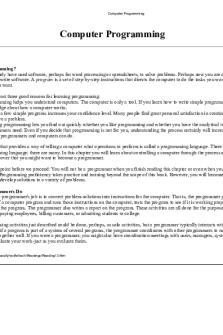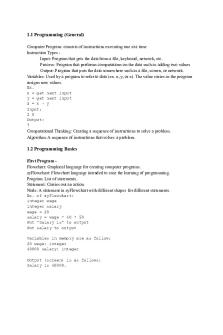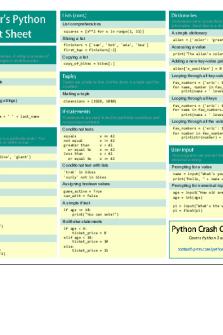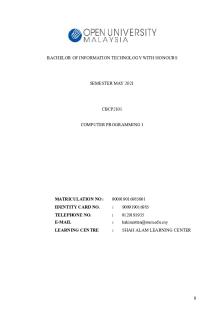Computer Programming python PDF

| Title | Computer Programming python |
|---|---|
| Course | Introduction To Programming |
| Institution | Rowan University |
| Pages | 15 |
| File Size | 945.2 KB |
| File Type | |
| Total Downloads | 13 |
| Total Views | 170 |
Summary
Download Computer Programming python PDF
Description
3/14/2020
Computer Programming
Computer Programming
Why Programming? You may already have used software, perhaps for word processing or spreadsheets, to solve problems. Perhaps now you are curious to learn how programmers write software. A program is a set of step-by-step instructions that directs the computer to do the tasks you want it to do and produce the results you want. There are at least three good reasons for learning programming: Programming helps you understand computers. The computer is only a tool. If you learn how to write simple programs, you will gain more knowledge about how a computer works. Writing a few simple programs increases your confidence level. Many people find great personal satisfaction in creating a set of instructions that solve a problem. Learning programming lets you find out quickly whether you like programming and whether you have the analytical turn of mind programmers need. Even if you decide that programming is not for you, understanding the process certainly will increase your appreciation of what programmers and computers can do. A set of rules that provides a way of telling a computer what operations to perform is called a programming language. There is not, however, just one programming language; there are many. In this chapter you will learn about controlling a computer through the process of programming. You may even discover that you might want to become a programmer. An important point before we proceed: You will not be a programmer when you finish reading this chapter or even when you finish reading the final chapter. Programming proficiency takes practice and training beyond the scope of this book. However, you will become acquainted with how programmers develop solutions to a variety of problems. What Programmers Do In general, the programmer's job is to convert problem solutions into instructions for the computer. That is, the programmer prepares the instructions of a computer program and runs those instructions on the computer, tests the program to see if it is working properly, and makes corrections to the program. The programmer also writes a report on the program. These activities are all done for the purpose of helping a user fill a need, such as paying employees, billing customers, or admitting students to college. The programming activities just described could be done, perhaps, as solo activities, but a programmer typically interacts with a variety of people. For example, if a program is part of a system of several programs, the programmer coordinates with other programmers to make sure that the programs fit together well. If you were a programmer, you might also have coordination meetings with users, managers, systems analysts, and with peers who evaluate your work-just as you evaluate theirs. https://homepage.cs.uri.edu/faculty/wolfe/book/Readings/Reading13.htm
1/15
3/14/2020
Computer Programming
Let us turn to the programming process. The Programming Process Developing a program involves steps similar to any problem-solving task. There are five main ingredients in the programming process: 1. Defining the problem 2. Planning the solution 3. Coding the program 4. Testing the program 5. Documenting the program Let us discuss each of these in turn. 1. Defining the Problem Suppose that, as a programmer, you are contacted because your services are needed. You meet with users from the client organization to analyze the problem, or you meet with a systems analyst who outlines the project. Specifically, the task of defining the problem consists of identifying what it is you know (input-given data), and what it is you want to obtain (output-the result). Eventually, you produce a written agreement that, among other things, specifies the kind of input, processing, and output required. This is not a simple process. 2. Planning the Solution Two common ways of planning the solution to a problem are to draw a flowchart and to write pseudocode, or possibly both. Essentially, a flowchart is a pictorial representation of a step-by-step solution to a problem. It consists of arrows representing the direction the program takes and boxes and other symbols representing actions. It is a map of what your program is going to do and how it is going to do it. The American National Standards Institute (ANSI) has developed a standard set of flowchart symbols. Figure 1 shows the symbols and how they might be used in a simple flowchart of a common everyday actpreparing a letter for mailing. Pseudocode is an English-like nonstandard language that lets you state your solution with more precision than you can in plain English but with less precision than is required when using a formal programming language. Pseudocode permits you to focus on the program logic without having to be concerned just yet about the precise syntax of a particular programming language. However, pseudocode is not executable on the computer. We will illustrate these later in this chapter, when we focus on https://homepage.cs.uri.edu/faculty/wolfe/book/Readings/Reading13.htm
2/15
3/14/2020
Computer Programming
language examples. 3. Coding the Program As the programmer, your next step is to code the programthat is, to express your solution in a programming language. You will translate the logic from the flowchart or pseudocode-or some other tool-to a programming language. As we have already noted, a programming language is a set of rules that provides a way of instructing the computer what operations to perform. There are many programming languages: BASIC, COBOL, Pascal, FORTRAN, and C are some examples. You may find yourself working with one or more of these. We will discuss the different types of languages in detail later in this chapter. Although programming languages operate grammatically, somewhat like the English language, they are much more precise. To get your program to work, you have to follow exactly the rules-the syntax-of the language you are using. Of course, using the language correctly is no guarantee that your program will work, any more than speaking grammatically correct English means you know what you are talking about. The point is that correct use of the language is the required first step. Then your coded program must be keyed, probably using a terminal or personal computer, in a form the computer can understand. One more note here: Programmers usually use a text editor, which is somewhat like a word processing program, to create a file that contains the program. However, as a beginner, you will probably want to write your program code on paper first. 4. Testing the Program Some experts insist that a well-designed program can be written correctly the first time. In fact, they assert that there are mathematical ways to prove that a program is correct. However, the imperfections of the world are still Figure 1: Flow Chart Symbols and Flow Chart For Mailing Letter with us, so most programmers get used to the idea that their newly written programs probably have a few errors. This is a bit discouraging at first, since programmers tend to be precise, careful, detail-oriented people who take pride in their work. Still, there are many opportunities to introduce mistakes into programs, and you, just as https://homepage.cs.uri.edu/faculty/wolfe/book/Readings/Reading13.htm
3/15
3/14/2020
Computer Programming
those who have gone before you, will probably find several of them. Eventually, after coding the program, you must prepare to test it on the computer. This step involves these phases: Desk-checking. This phase, similar to proofreading, is sometimes avoided by the programmer who is looking for a shortcut and is eager to run the program on the computer once it is written. However, with careful desk-checking you may discover several errors and possibly save yourself time in the long run. In desk-checking you simply sit down and mentally trace, or check, the logic of the program to attempt to ensure that it is error-free and workable. Many organizations take this phase a step further with a walkthrough, a process in which a group of programmers-your peers-review your program and offer suggestions in a collegial way. Translating. A translator is a program that (1) checks the syntax of your program to make sure the programming language was used correctly, giving you all the syntax-error messages, called diagnostics, and (2) then translates your program into a form the computer can understand. A by-product of the process is that the translator tells you if you have improperly used the programming language in some way. These types of mistakes are called syntax errors. The translator produces descriptive error messages. For instance, if in FORTRAN you mistakenly write N=2 *(I+J))-which has two closing parentheses instead of one-you will get a message that says, "UNMATCHED PARENTHESES." (Different translators may provide different wording for error messages.) Programs are most commonly translated by a compiler. A compiler translates your entire program at one time. The translation involves your original program, called a source module, which is transformed by a compiler into an object module. Prewritten programs from a system library may be added during the link/load phase, which results in a load module. The load module can then be executed by the computer. Debugging. A term used extensively in programming, debugging means detecting, locating, and correcting bugs (mistakes), usually by running the program. These bugs are logic errors, such as telling a computer to repeat an operation but not telling it how to stop repeating. In this phase you run the program using test data that you devise. You must plan the test data carefully to make sure you test every part of the program. 5. Documenting the Program Documenting is an ongoing, necessary process, although, as many programmers are, you may be eager to pursue more exciting computercentered activities. Documentation is a written detailed description of the programming cycle and specific facts about the program. Typical program documentation materials include the origin and nature of the problem, a brief narrative description of the program, logic tools such as flowcharts and pseudocode, data-record descriptions, program listings, and testing results. Comments in the program itself are also considered an essential part of documentation. Many programmers document as they code. In a broader sense, program documentation can be part of the documentation for an entire system. The wise programmer continues to document the program throughout its design, development, and testing. Documentation is needed to supplement human memory and to help organize program planning. Also, documentation is critical to communicate with others who have an interest in the program, especially other programmers who may be part of a programming team. And, since turnover is high in the computer industry, written documentation is needed so that those who come after you can make any necessary modifications in the program or track down any errors that you missed.
Programming as a Career There is a shortage of qualified personnel in the computer field. Before you join their ranks, consider the advantages of the computer field and wha it takes to succeed in it. https://homepage.cs.uri.edu/faculty/wolfe/book/Readings/Reading13.htm
4/15
3/14/2020
Computer Programming
The Joys of the Field Although many people make career changes into the computer field, few choose to leave it. In fact, surveys of computer professionals, especially programmers, consistently report a high level of job satisfaction. There are several reasons for this contentment. One is the challenge-most jobs in the computer industry are not routine. Another is security, since established computer professionals can usually find work. And that work pays well-you will probably not be rich, but you should be comfortable. The computer industry has historically been a rewarding place for women and minorities. And, finally, the industry holds endless fascination since it is always changing. What It Takes You need, of course, some credentials, most often a two- or four-year degree in computer information systems or computer science. The requirements and salaries vary by the organization and the region, so we will not dwell on these here. Beyond that, the person most likely to land a job and move up the career ladder is the one with excellent communication skills, both oral and written . These are also the qualities that can be observed by potential employers in an interview. Promotions are sometimes tied to advanced degrees (an M.B.A. or an M.S. in computer science). Open Doors The overall outlook for the computer field is promising. The Bureau of Labor Statistics shows, through the year 2010, a 72 percent increase in programmers and a 69 percent increase in system use today, and we will discuss the most popular ones later In the chapter. Before we turn to specific languages, however, we need to discuss levels of language. Levels of Language Programming languages are said to be "lower" or "higher," depending on how close they are to the language the computer itself uses (Os and 1s = low) or to the language people use (more English-like-high). We will consider five levels of language. They are numbered 1 through 5 to correspond to levels, or generations. In terms of ease of use and capabilities, each generation is an improvement over its predecessors. The five generations of languages are 1. Machine language 2. Assembly languages 3. High-level languages 4. Very high-level languages 5. Natural languages Let us look at each of these categories. Machine Language Humans do not like to deal in numbers alone-they prefer letters and words. But, strictly speaking, numbers are what machine language is. This lowest level of language, machine language, represents data and program instructions as 1s and Os-binary digits corresponding to the on and off electrical states in the computer. Each type of computer has its own machine language. In the early days of computing, programmers had rudimentary systems for combining numbers to represent instructions such as add and compare. Primitive by today's standards, the programs were not convenient for people to read and use. The computer industry quickly moved to develop assembly languages. Assembly Languages Today, assembly languages are considered very low level-that is, they are not as convenient for people to use https://homepage.cs.uri.edu/faculty/wolfe/book/Readings/Reading13.htm
5/15
3/14/2020
Computer Programming
as more recent languages. At the time they were developed, however, they were considered a great leap forward. To replace the Is and Os used in machine language, assembly languages use mnemonic codes, abbreviations that are easy to remember: A for Add, C for Compare, MP for Multiply, STO for storing information in memory, and so on. Although these codes are not English words, they are still- from the standpoint of human convenience-preferable to numbers (Os and 1s) alone. Furthermore, assembly languages permit the use of names- perhaps RATE or TOTAL-for memory locations instead of actual address numbers. just like machine language, each type of computer has its own assembly language. The programmer who uses an assembly language requires a translator to convert the assembly language program into machine language. A translator is needed because machine language is the only language the computer can actually execute. The translator is an assembler program, also referred to as an assembler. It takes the programs written in assembly language and turns them into machine language. Programmers need not worry about the translating aspect; they need only write programs in assembly language. The translation is taken care of by the assembler. Although assembly languages represent a step forward, they still have many disadvantages. A key disadvantage is that assembly language is detailed in the extreme, making assembly programming repetitive, tedious, and error prone. This drawback is apparent in the program in Figure 2. Assembly language may be easier to read than machine language, but it is still tedious. High-Level Languages The first widespread use of high-level languages in the Figure 2: Example Assembly Language Program early 1960s transformed programming into something quite different from what it had been. Programs were written in an English-like manner, thus making them more convenient to use. As a result, a programmer could accomplish more with less effort, and programs could now direct much mor complex tasks. These so-called third-generation languages spurred the great increase in data processing that characterized the 1960s and 1970s. During that time https://homepage.cs.uri.edu/faculty/wolfe/book/Readings/Reading13.htm
6/15
3/14/2020
Computer Programming
the number of mainframes in use increased from hundreds to tens of thousands. The impact of third-generation languages on our society has been enormous. Of course, a translator is needed to translate the symbolic statements of a high-level language into computer-executable machine language; this translator is usually a compiler. There are many compilers for each language and one for each type of computer. Since the machine language generated by one computer's COBOL compiler, for instance, is not the machine language of some other computer, it is necessary to have a COBOL compiler for each type of computer on which COBOL programs are to be run. Keep in mind, however, that even though a given program would be compiled to different machine language versions on different machines, the source program itself-the COBOL version-can be essentially identical on each machine. Some languages are created to serve a specific purpose, such as controlling industrial robots or creating graphics. Many languages, however, are extraordinarily flexible and are considered to be general-purpose. In the past the majority of programming applications were written in BASIC, FORTRAN, or COBOL-all general-purpose languages. In addition to these three, another popular high-level language is C, which we will discuss later. Very High-Level Languages Languages called very high-level languages are often known by their generation number, that is, they are called fourth-generation languages or, more simply, 4GLs. Definition Will the real fourth-generation languages please stand up? There is no consensus about what constitutes a fourth-generation language. The 4GLs are essentially shorthand programming languages. An operation that requires hundreds of lines in a third-generation language such as COBOL typically requires only five to ten lines in a 4GL. However, beyond the basic criterion of conciseness, 4GLs are difficult to describe. Characteristics Fourth-generation languages share some characteristics. The first is that they make a true break with the prior generation-they are basically nonprocedural. A procedural language tells the computer how a task is done: Add this, compare that, do this if something is true, and so forth-a very specific step-by-step process. The first three generations of languages are all procedural. In a nonprocedural language, the concept changes. Here, users define only what they want the computer to do; the user does not provide the details of just how it is to be done. Obviously, it is a lot easier and faster just to say what you want rather than how to get it. This leads us to the issue of productivity, a key characteristic of fourth-generation languages. Productivity Folklore has it that fourth-generation languages can improve productivity by a factor of 5 to 50. The folklore is true. Most experts say the average improvement factor is about 10-that is, you can be ten times more productive in a fourth-generation language than in a third-generation language. Consider this request: Produce a report showing the total units sold for each product, by customer, in each month and year, and with a subtotal for each customer. In addition, each new customer must start o...
Similar Free PDFs

Computer Programming python
- 15 Pages

Programming with python-3
- 82 Pages

Lab04 - Python Programming.
- 11 Pages

Computer Programming Laboratory 1
- 10 Pages

Computer Programming Notes
- 39 Pages

Computer programming viva qus
- 18 Pages

GUI Programming using Python Tkinter
- 62 Pages

Python Programming Hand Written Notes
- 121 Pages
Popular Institutions
- Tinajero National High School - Annex
- Politeknik Caltex Riau
- Yokohama City University
- SGT University
- University of Al-Qadisiyah
- Divine Word College of Vigan
- Techniek College Rotterdam
- Universidade de Santiago
- Universiti Teknologi MARA Cawangan Johor Kampus Pasir Gudang
- Poltekkes Kemenkes Yogyakarta
- Baguio City National High School
- Colegio san marcos
- preparatoria uno
- Centro de Bachillerato Tecnológico Industrial y de Servicios No. 107
- Dalian Maritime University
- Quang Trung Secondary School
- Colegio Tecnológico en Informática
- Corporación Regional de Educación Superior
- Grupo CEDVA
- Dar Al Uloom University
- Centro de Estudios Preuniversitarios de la Universidad Nacional de Ingeniería
- 上智大学
- Aakash International School, Nuna Majara
- San Felipe Neri Catholic School
- Kang Chiao International School - New Taipei City
- Misamis Occidental National High School
- Institución Educativa Escuela Normal Juan Ladrilleros
- Kolehiyo ng Pantukan
- Batanes State College
- Instituto Continental
- Sekolah Menengah Kejuruan Kesehatan Kaltara (Tarakan)
- Colegio de La Inmaculada Concepcion - Cebu







